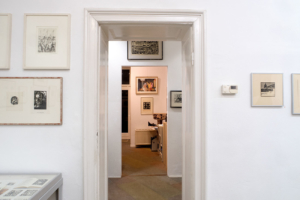Dear Ladies and Gentlemen,
we cordially invite you to visit our new exhibition
Flowers – Approaches to a Contentious Motif.
Exhibition: May 30 to July 28, 2020
Opening: Fri, May 29, 2–10 pm, only on prior appointment
Closing event: Tuesday 28 from 5–10pm
Because of the current situation, we regret to not be able to have an opening with many guests all at the same time. To allow only the permitted number of visitors, please use the form on our website to announce your visit (available soon). You can also write us an e-mail or just give us a call.
You can find a digital tour of the flower exhibition on our German website.
Artists
Gallery
- Gisa Hausmann
- Marina Koldobskaya
- Mr. Ira Schneider
Cabinett
- Mariam Azlamazyan
- G. von Galentz
- Brigitta Friedrich
- Joseph Heeg
- Alexander Horn
- Thomas Kaemmerer
- Philipp Mager
- Oleg Neishtadt
- Jürgen Wittdorf
- and other artists from our collection
Flowers – Approaches to a Contentious Motif
‘It is unseemly for a contemporary artist to paint flowers,’ writes Marina Koldobskaya, one of the artists of the upcoming exhibition at Wolf & Galentz. Who paints flowers in spite of that, she continues, risks loosing their reputation as a serious artist.
This is because flowers are presumed to be decorative, and the decorative to be incompatible with contemporary art – such, at any rate, the discourse on contemporary art tells us, and also that art is supposed to be difficult, ugly, disrupted in some way or that it should concern itself with political issues.
Thus, Gisela Breitling writes in an article about Gisa Hausmann’s flower pictures (also in the exhibition): ‘nowadays, beauty in art is a much bigger challenge for the arts than everything we usually deem artistic provocation’.
Fortunately, contemporary art itself does not, other than the discourse, abide by this ban on flowers in the service of avoiding the beautiful, but it faces the challenge, otherwise the remarkable pictures in the exhibition wouldn’t exist and we couldn’t see them.
The three artist shown in the big main room of the gallery, Gisa Hausmann, Marina Koldobskaya and Ira Schneider, three very different positions, present a broad variety of possible approaches to flowers.
Drawings and prints reworked in watercolours by Berlin artist Gisa Hausmann (1942–2015) show hothouse flowers and other obviously non-native, but artfully bred flowers in realist detail and in a style that is reminiscent of Jugendstil.
Marina Koldobskaya (b. 1961) paints in acrylic on paper or canvas; in clear, simplified shapes her bold and expressive flowers grow alone, in small groups or even whole fields; flower beds, meadows, drug plantations, as she herself states. She lives and works in St. Petersburg, Russia.
Ira Schneider, born and raised in New York (b. 1939), video artist and one of the most important pioneers of video art in the sixties and seventies, photographs flowers, in his own small garden in Berlin Wedding among other places, with a concave mirror. The photos made thusly feature an interesting similarity to non-objective paintings, since the distortion engenders abstraction. He points out that ‘human beings are made up of 67 % water and 33 % flowers’. Ira Schneider continues to produce video works, a new one will be will be exhibited throughout the current exhibition.
In the gallery’s smaller room, the cabinet, several more artists are shown with one or two works each: Mariam Aslamazyan, Hermann Bachmann, Brigitta Friedrich, Klaus Fußmann, Archi Galentz, G. von Galentz, Joseph Heeg, Alexander Horn, Thomas Kaemmerer, Philipp Mager, Oleg Neishtadt, Nazeli Nikogosyan and Jürgen Wittdorf.
The pictures are small and of middle size, they are etchings, oil or gouache paintings and paintings made by pouring paint over the canvas. The exhibition will be transformed into a garden with a vast variety of interesting flowers.
We are looking forward to your visit!
Image: Gisa Hausmann, Seidenmohn [Shirley Poppy], 1996, 38 x 56 cm (detail)































